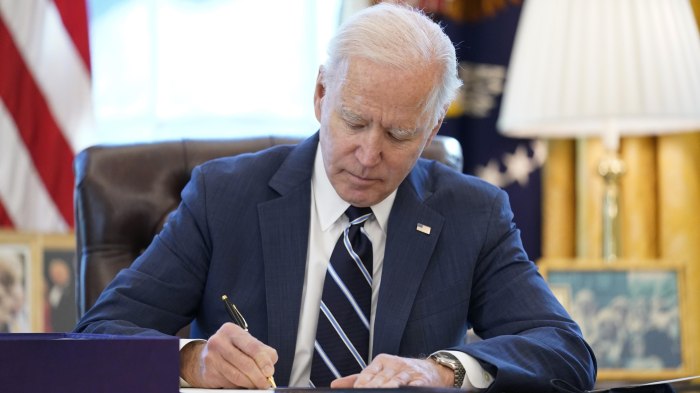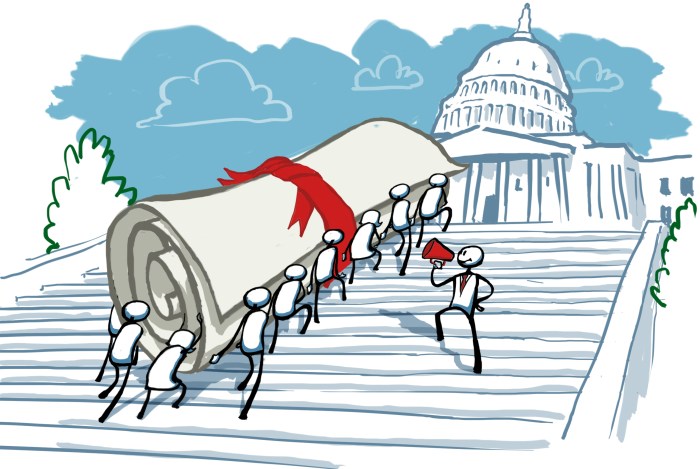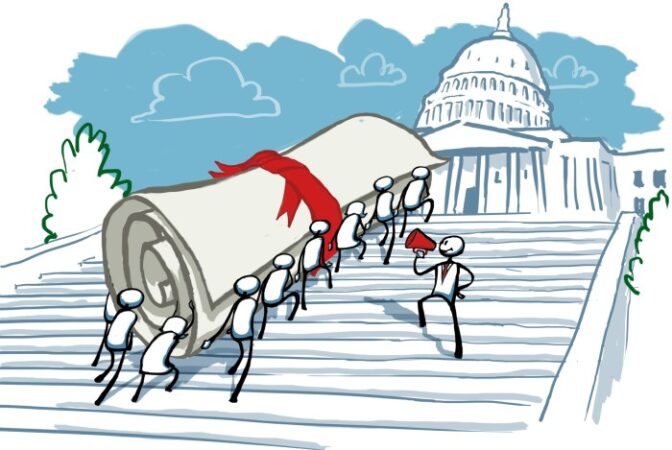
Who signs bills into law? The President of the United States holds the power to enact legislation passed by Congress, a pivotal role in the American political system. This power, enshrined in the Constitution, grants the President the authority to shape the nation’s laws and influence the direction of policy.
The process of a bill becoming law is complex, involving multiple steps and potential points of contention. It begins with the introduction of a bill in either the House of Representatives or the Senate, followed by debates, amendments, and votes. If both chambers approve the bill, it is sent to the President for consideration. The President then has the option to sign the bill into law, veto it, or allow it to become law without a signature after ten days.
The Role of the President
The President of the United States plays a crucial role in the legislative process, specifically in the bill signing process. This role is enshrined in the Constitution and has evolved significantly throughout American history.
Constitutional Authority
The President’s authority to sign bills into law is explicitly Artikeld in Article I, Section 7 of the United States Constitution. This provision states that “Every Bill which shall have passed the House of Representatives and the Senate, shall, before it become a Law, be presented to the President of the United States; If he approve he shall sign it, but if not he shall return it, with his Objections to that House in which it shall have originated, who shall enter the Objections at large on their Journal, and proceed to reconsider it.”
This provision grants the President the power to either approve or reject a bill passed by Congress. If the President approves the bill, it becomes law. If the President disapproves, they can veto the bill, returning it to Congress with their objections. Congress can then override the President’s veto with a two-thirds majority vote in both the House and Senate.
Historical Significance
The President’s role in lawmaking has been a subject of debate and evolution throughout American history. The Founding Fathers intended the President to act as a check on the power of Congress, ensuring that laws were consistent with the Constitution and the will of the people.
The first President, George Washington, established a precedent for the President’s role in lawmaking by carefully considering bills and providing detailed explanations for his decisions. This practice helped to solidify the President’s position as a key player in the legislative process.
Instances of Presidential Vetoes, Who signs bills into law
Throughout history, Presidents have exercised their veto power on numerous occasions. Some notable examples include:
- In 1866, President Andrew Johnson vetoed the Reconstruction Acts, which aimed to reintegrate the Southern states into the Union after the Civil War. This veto was overridden by Congress, demonstrating the power of Congress to overrule the President’s objections.
- In 1946, President Harry Truman vetoed the Taft-Hartley Act, which aimed to restrict the power of labor unions. This veto was overridden by Congress, highlighting the potential for political clashes between the President and Congress.
- In 2016, President Barack Obama vetoed the Justice Against Sponsors of Terrorism Act (JASTA), which aimed to allow victims of the 9/11 attacks to sue the Saudi Arabian government. This veto was overridden by Congress, illustrating the potential for Congress to overturn the President’s decision on foreign policy matters.
These examples demonstrate the significance of the President’s role in the bill signing process. The President’s decision to sign or veto a bill can have a profound impact on the course of legislation and the direction of the country.
The Legislative Process
The legislative process is the journey a bill takes from its introduction to its enactment into law. This process involves multiple stages, each with its own set of procedures and opportunities for the bill to be amended or rejected. Understanding the legislative process is crucial for understanding how laws are made and how citizens can participate in the process.
The Stages of the Legislative Process
The legislative process can be broadly divided into the following stages:
- Introduction: A bill is introduced in either the House of Representatives or the Senate by a member of Congress. The bill is then given a number and assigned to a relevant committee for review.
- Committee Review: The committee holds hearings, gathers information, and drafts amendments to the bill. The committee may choose to report the bill to the floor of the House or Senate, or it may choose to table the bill, effectively killing it.
- Floor Debate and Vote: If the bill is reported out of committee, it is debated and voted on by the full House or Senate. This is where the bill can be amended or rejected. If the bill passes, it is sent to the other chamber of Congress.
- Conference Committee: If the House and Senate versions of the bill differ, a conference committee is formed to reconcile the differences. The conference committee creates a compromise version of the bill, which is then sent back to both chambers for another vote.
- Presidential Action: Once both chambers have passed the same version of the bill, it is sent to the President. The President can sign the bill into law, veto the bill, or allow the bill to become law without signing it after 10 days. If the President vetoes the bill, Congress can override the veto with a two-thirds majority vote in both chambers.
The Roles of the House and Senate
The House of Representatives and the Senate play distinct roles in the bill signing process. The House, with its larger size and shorter term lengths, tends to be more responsive to public opinion and more likely to focus on issues that are important to their constituents. The Senate, with its smaller size and longer term lengths, tends to be more deliberative and less likely to be influenced by short-term political pressures.
“The House of Representatives is designed to be more responsive to the people, while the Senate is designed to be more deliberative.”
The House and Senate have different rules and procedures for debating and voting on bills. The House has a more structured process, with limits on debate time and amendments. The Senate has a more open process, with fewer restrictions on debate and amendments. These differences reflect the different roles that the two chambers play in the legislative process.
The Process of Signing a Bill

Once a bill has been passed by both the House of Representatives and the Senate, it is sent to the President for their signature. The President has ten days (excluding Sundays) to act on a bill.
Presidential Actions on a Bill
The President has several options when presented with a bill:
- Sign the Bill: This is the most common action. If the President signs the bill, it becomes law.
- Veto the Bill: The President can reject the bill by issuing a veto. This means the bill does not become law unless Congress overrides the veto.
- Do Nothing: If the President does not sign or veto the bill within ten days, it becomes law automatically. However, this only applies if Congress is in session. If Congress is not in session, the bill is automatically vetoed.
Consequences of a Presidential Veto
If the President vetoes a bill, it is returned to Congress with a statement of reasons. Congress can override the veto with a two-thirds majority vote in both the House and the Senate. This is a difficult process, as it requires significant support from both parties.
Types of Presidential Actions
The following table summarizes the different types of presidential actions that can be taken on a bill:
| Action | Description | Result |
|---|---|---|
| Sign | The President approves the bill. | The bill becomes law. |
| Veto | The President rejects the bill. | The bill is returned to Congress. It can be overridden by a two-thirds majority vote in both the House and the Senate. |
| Do Nothing (Congress in Session) | The President takes no action within ten days. | The bill becomes law. |
| Do Nothing (Congress Not in Session) | The President takes no action within ten days. | The bill is automatically vetoed. |
The Impact of the Bill Signing Process

The President’s decision to sign or veto a bill has significant implications for the legislative process and the shape of American law. The bill signing process is a crucial step in the lawmaking process, and the President’s decision can have a profound impact on the nation.
The Implications of Presidential Action
The President’s decision to sign or veto a bill has direct consequences for the legislative process. If the President signs a bill, it becomes law. If the President vetoes a bill, it is returned to Congress. Congress can then override the President’s veto with a two-thirds majority vote in both the House and the Senate. This process allows for checks and balances between the executive and legislative branches, ensuring that no single branch has absolute power.
Historical Impact of the Bill Signing Process
The bill signing process has played a significant role in shaping American law throughout history. Some notable examples include:
* The Civil Rights Act of 1964: President Lyndon B. Johnson’s signing of this landmark legislation marked a turning point in the fight for racial equality in the United States.
* The Affordable Care Act: President Barack Obama’s signing of this act in 2010 expanded health insurance coverage to millions of Americans.
* The Tax Cuts and Jobs Act of 2017: President Donald Trump’s signing of this bill resulted in significant changes to the U.S. tax code.
Flowchart Illustrating the Bill Signing Process
The following flowchart illustrates the different paths a bill can take after being passed by Congress:
[Flowchart description]
Congress passes a bill -> President signs the bill -> Bill becomes law
Congress passes a bill -> President vetoes the bill -> Bill returned to Congress
Congress overrides the President’s veto -> Bill becomes law
Congress fails to override the President’s veto -> Bill is rejected
The Importance of the Bill Signing Process
The President’s role in signing bills into law is not merely a formality. It represents a crucial step in the legislative process, impacting the lives of citizens and shaping the nation’s future. The President’s decision to sign or veto a bill carries significant weight, underscoring the power vested in this office.
Historical Examples of the Bill Signing Process
Throughout history, the bill signing process has played a pivotal role in shaping American legislation and impacting society. Here are some notable examples:
- The signing of the Civil Rights Act of 1964 by President Lyndon B. Johnson marked a turning point in the fight for racial equality. This landmark legislation outlawed discrimination based on race, color, religion, sex, or national origin, significantly impacting the social fabric of the nation.
- President Franklin D. Roosevelt’s signing of the Social Security Act in 1935 established a social safety net for millions of Americans, providing financial security for retirees, the unemployed, and the disabled. This legislation significantly impacted the lives of countless individuals, creating a social welfare system that continues to serve as a cornerstone of American society.
- President Barack Obama’s signing of the Affordable Care Act in 2010 aimed to expand health insurance coverage to millions of Americans. This legislation, despite its controversies, has had a significant impact on the healthcare landscape in the United States, leading to changes in access to healthcare and the cost of healthcare.
Potential for Abuse or Manipulation
While the bill signing process is a vital part of the legislative process, it also presents potential for abuse or manipulation.
- Political Pressure: Presidents may face intense pressure from political parties, interest groups, or lobbyists to sign or veto bills, potentially leading to decisions that prioritize political expediency over the best interests of the nation.
- Lack of Transparency: The process of signing bills can sometimes lack transparency, raising concerns about potential backroom deals or undue influence by special interests.
- Abuse of Power: Presidents, in rare instances, may use their power to sign bills that benefit themselves or their allies, potentially at the expense of the public good.
Closure: Who Signs Bills Into Law

The President’s role in the bill signing process is crucial to the balance of power within the American government. This process allows for checks and balances, ensuring that no single branch has absolute authority. The President’s decision to sign or veto a bill can have a profound impact on the nation’s laws and policies, shaping the future of the country. Understanding the intricacies of the bill signing process is essential for any citizen interested in the workings of American democracy.
User Queries
What happens if the President vetoes a bill?
If the President vetoes a bill, it is returned to Congress. Congress can then override the veto with a two-thirds majority vote in both the House and the Senate. If the veto is overridden, the bill becomes law without the President’s signature.
What are some examples of historical bills that were vetoed?
Some notable examples include President Andrew Jackson’s veto of the Bank of the United States recharter bill in 1832, and President Franklin D. Roosevelt’s veto of the Bonus Army bill in 1932.
Can the President sign a bill into law without reading it?
While the President is not legally required to read every bill before signing it, it is generally considered best practice. Presidents often rely on advisors and legal counsel to review bills and provide summaries.





